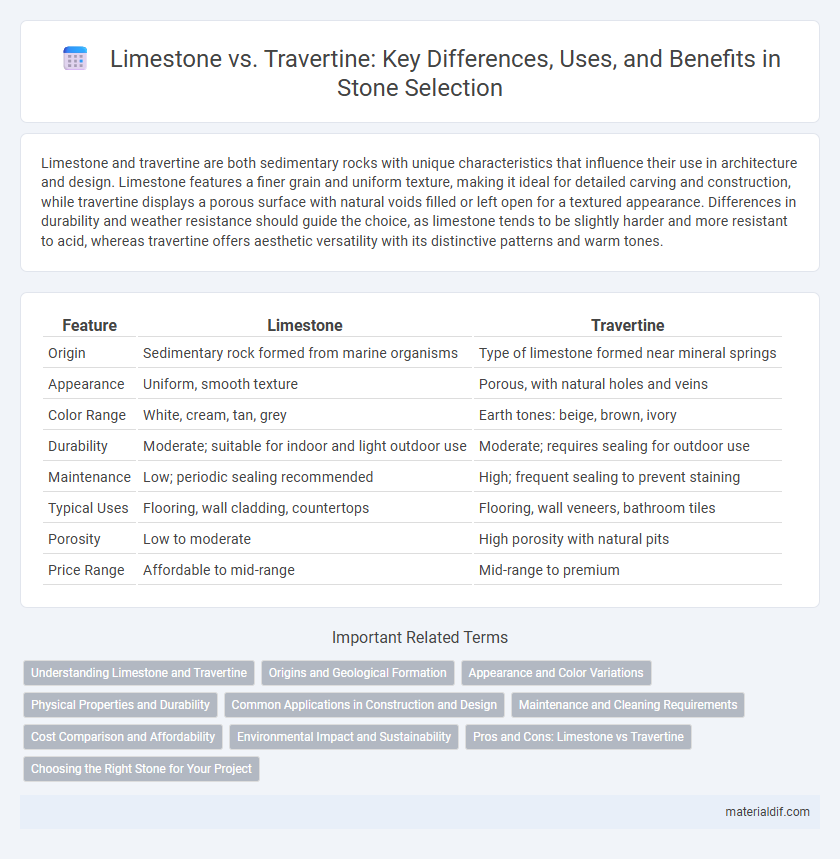Limestone and travertine are both sedimentary rocks with unique characteristics that influence their use in architecture and design. Limestone features a finer grain and uniform texture, making it ideal for detailed carving and construction, while travertine displays a porous surface with natural voids filled or left open for a textured appearance. Differences in durability and weather resistance should guide the choice, as limestone tends to be slightly harder and more resistant to acid, whereas travertine offers aesthetic versatility with its distinctive patterns and warm tones.
Table of Comparison
| Feature | Limestone | Travertine |
|---|---|---|
| Origin | Sedimentary rock formed from marine organisms | Type of limestone formed near mineral springs |
| Appearance | Uniform, smooth texture | Porous, with natural holes and veins |
| Color Range | White, cream, tan, grey | Earth tones: beige, brown, ivory |
| Durability | Moderate; suitable for indoor and light outdoor use | Moderate; requires sealing for outdoor use |
| Maintenance | Low; periodic sealing recommended | High; frequent sealing to prevent staining |
| Typical Uses | Flooring, wall cladding, countertops | Flooring, wall veneers, bathroom tiles |
| Porosity | Low to moderate | High porosity with natural pits |
| Price Range | Affordable to mid-range | Mid-range to premium |
Understanding Limestone and Travertine
Limestone is a sedimentary rock primarily composed of calcite, formed from marine organism remains over millions of years, known for its durability and uniform texture. Travertine, a type of limestone, is characterized by its porous surface and banded, fibrous appearance, formed by mineral deposits from natural springs. Both stones are widely used in construction and design, with limestone offering a solid, consistent surface while travertine provides a unique, earthy aesthetic due to its distinctive voids and patterns.
Origins and Geological Formation
Limestone forms primarily from the accumulation of marine organism shells and skeletal fragments, composed mainly of calcium carbonate, deposited in warm, shallow marine environments over millions of years. Travertine, a type of limestone, develops through rapid precipitation of calcium carbonate from mineral-rich hot springs or groundwater, often creating banded, porous textures. The key geological distinction is that limestone originates from biochemical sedimentation in oceanic settings, while travertine is a chemical sedimentary rock formed in freshwater environments via carbonate deposition.
Appearance and Color Variations
Limestone typically features a uniform, matte surface with subtle color variations ranging from beige and cream to light gray, often containing fossilized remains that add natural texture. Travertine displays a more porous, textured surface with distinctive vein patterns and a broader color palette including warm tones like ivory, tan, rust, and occasionally deep brown or gold hues. The unique appearance of travertine, marked by its pitted holes and fibrous texture, contrasts sharply with the smoother, more consistent look of limestone.
Physical Properties and Durability
Limestone exhibits a softer texture with a Mohs hardness of 3 to 4, making it more prone to scratching and erosion, while travertine, a form of limestone, features a denser structure with natural voids often filled for enhanced durability. Travertine's porosity varies between 10% to 20%, requiring sealing to prevent staining, whereas limestone generally has a slightly higher porosity, increasing its susceptibility to weathering. Both stones are durable in moderate climates, but travertine's compactness and resistance to freeze-thaw cycles offer superior longevity in outdoor applications.
Common Applications in Construction and Design
Limestone is widely used in construction for building facades, flooring, and outdoor paving due to its durability and versatility. Travertine, characterized by its porous texture and distinct veining, is preferred for interior design elements such as bathroom walls, countertops, and decorative tiles. Both stones are favored for their natural beauty and ability to withstand environmental factors, making them popular choices in residential and commercial projects.
Maintenance and Cleaning Requirements
Limestone requires gentle cleaning with pH-neutral cleaners to prevent etching and discoloration, making maintenance relatively delicate. Travertine, characterized by its natural pores, demands regular sealing to protect against stains and moisture penetration, which is crucial for preserving its appearance. Both stones benefit from prompt spill cleanup, but Travertine's sealing needs result in slightly higher long-term maintenance compared to Limestone.
Cost Comparison and Affordability
Limestone generally offers greater affordability compared to travertine, with prices often ranging between $2 to $10 per square foot, making it a cost-effective option for large-scale projects. Travertine, known for its unique porous texture and aesthetic appeal, typically costs between $5 to $15 per square foot, reflecting higher quarrying and finishing expenses. Buyers prioritizing budget constraints often opt for limestone due to its lower installation and maintenance costs, whereas travertine suits premium applications despite its higher price point.
Environmental Impact and Sustainability
Limestone extraction generally has a lower environmental impact compared to travertine due to its more abundant availability and less intensive quarrying process. Travertine quarrying often involves significant water usage and energy consumption, leading to higher carbon emissions and ecosystem disruption. Sustainable sourcing practices and efficient waste management can mitigate environmental consequences for both stone types in construction projects.
Pros and Cons: Limestone vs Travertine
Limestone offers excellent durability and a natural, matte finish ideal for both indoor and outdoor applications but can be more prone to staining and requires regular sealing. Travertine provides a unique, porous texture with warm tones and high slip resistance, making it perfect for flooring and pool areas, though it may show wear more quickly and demands careful maintenance. Choosing between limestone and travertine depends on the balance between aesthetic preference, maintenance commitment, and intended use in construction or design projects.
Choosing the Right Stone for Your Project
Limestone offers a durable, porous composition ideal for both indoor and outdoor applications, providing natural resistance to wear and weathering. Travertine, characterized by its distinctive veining and lighter density, excels in decorative flooring and wall cladding, adding an elegant, classic aesthetic. Selecting between limestone and travertine depends on project requirements such as durability, appearance, and installation environment to ensure optimal performance and visual appeal.
Limestone vs Travertine Infographic

 materialdif.com
materialdif.com